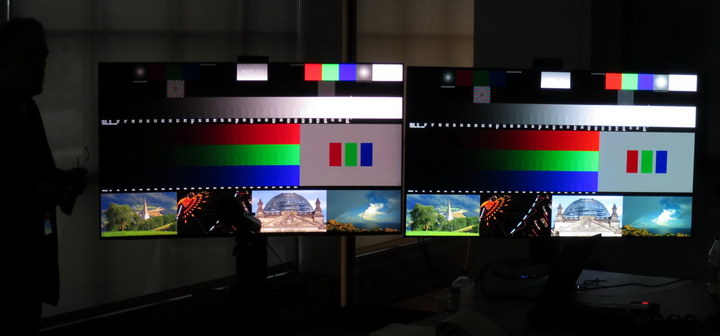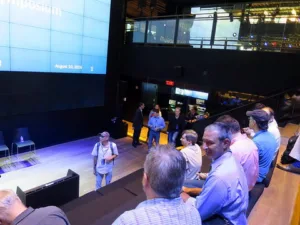My Display Daily on August 10th discussed the relationship between HDR10 and Dolby Vision. That evening I attended a High Dynamic Range (HDR) event in New York hosted by Samsung and Insight Media, held in the Samsung 837 venue. Samsung is in the HDR10 camp and there was little discussion of Dolby Vision or the minor players in the HDR field like Philips, Technicolor, NHK or the BBC.
There is one minor error in my DD, where I say HDR10 is a profile within the ITU BT.2100 HDR standard. This is not really true – the only standard directly associated with HDR10 is SMPTE ST-2084 that standardizes the PQ EOTF. The PQ EOTF definition is also in BT.2100. Besides ST-2084, SMPTE ST-2085, ST-2086 and ST-2094 also relate to HDR. The ITU Rec. 2020 color spec also plays a major role. None of the HDR experts speaking at the Samsung event could cite a single source for HDR10 other than the Blu-ray Disc Association (BDA). One of my correspondents called HDR10 a “a hotsch potsch of SMPTE standards 2084 [and] 2086 with a few extra items like mastering volume, brightness metadata thrown in.” The more I learn about HDR10, the more I agree with him. This industry developed de-facto specification is not inherently bad, however, because standards bodies commonly lag behind industry in new fields of technology like HDR.
When I suggested to Samsung the formation of a HDR10 Consortium or Alliance to present HDR10 in a more coherent manner, they thought it was a good idea. Rather than create a new organization, perhaps this could be done within the BDA, although I can’t see the streaming HDR10 people such as Amazon and Netflix having any interest in joining the BDA.
The Samsung 837 main stage was the venue for the HDR workshop presentations and panel.
The evening at Samsung was by invitation only and was attended by about 30 industry experts. It started with an overview talk by Gerard Catapano, director, Samsung Electronics America, QA Lab. This was needed because you can be a television industry expert and still not be very familiar with the very new technology of HDR imaging for TV. According to Catapano, besides SMPTE and the BDA, the ITU, MPEG, the Consumer Technology Association (CTA) and the UHD Alliance all have had a hand in the HDR10 “standard.”
Catapano said that consumers can get HDR content today via HDMI 2.0a, streaming or via USB from an external storage device and in the future will be able to get HDR content from broadcast. He explained that HDMI 2.0a was required because HDMI 2.0 is unable to transmit the required metadata needed to implement HDR10. Currently, most consumers get their HDR content from either a UltraHD Blu-ray player such as the Samsung UBD-K8500 or from a streaming service. Besides Amazon and Netflix, he said VUDU, YouTube, UltraFlix and FandangoNOW were streaming HDR content.
As I said, even some industry experts are not familiar with HDR imaging so you can imagine what more typical consumers think. Catapano said the BDA, CTA and the Digital Entertainment Group (DEG) are running active consumer education programs on HDR. In addition, TV manufacturers offering HDR sets typically explain about HDR on their websites. In my DD, I gave LG’s website, so for completeness, Samsung’s is here. Note that, on its website, Samsung calls it HDR-1000, not HDR10. I’ve seen this designation elsewhere also, and I believe it derives from the fact that the content is mastered for displays with about a 1000 nit of brightness.
Florian Friedrich, Managing Director of AVTOP and Kevin Miller of ISFTV gave a talk titled “Introduction to HDR Reference Disc and CalMan Workflow.” He discussed not only the CalMan workflow, but technical issues that affect HDR TVs. These included the importance of Rec. 2020 colorimetry, the PQ EOTF and competing EOTFs; and improvements in the dynamic range of imaging systems. According to them, cinema-grade digital cameras now have a higher dynamic range than film acquisition. HDR at 4000 or 10,000 nits (e.g. Dolby Vision) also have higher dynamic ranges than a film display. HDR at 1000 nits has slightly lower dynamic range than the best films, they say.
 Panelists at the Samsung HDR workshop August 10. Left to right: Steve Panosian, Gerard Catapano, Jason Hartlove, Florian Friedrich and moderator, Chris Chinnock.
Panelists at the Samsung HDR workshop August 10. Left to right: Steve Panosian, Gerard Catapano, Jason Hartlove, Florian Friedrich and moderator, Chris Chinnock.
The final main-stage event was a panel discussion with Florian Friedrich; Steve Panosian, Director of Marketing, Video Display Group, Samsung; Gerard Catapano; and Jason Hartlove, CEO of Nanosys. Chris Chinnock of Insight Media was the moderator. In my DD, I mentioned that one of the limitations on HDR and the high-brightness displays needed to properly support HDR were regulatory limitations on TV power consumption. Hartlove said this is becoming less and less of a problem because of the increasing efficiency of Quantum Dot (QD) based LCD TV sets. These QD TVs are already more efficient than TVs based on white LEDs and color filters and Hartlove sees room for at least a 3:1 improvement in QD TV power efficiency over current QD TVs. He also said the efficiency gap between cadmium-based QDs and no-cadmium QDs was closing. This is important because he expects the RoHS waiver allowing cadmium in QDs to eventually be ended. (QD Wars Continue in Europe) Since HDR with LCD displays need a segmented backlight in order to achieve the contrast levels required for HDR, this also lowers the power consumed.
After the talks, the attendees broke into three groups to get a demonstration of the CalMan-5 HDR calibration workflow. This was similar to what Samsung had shown earlier at CE Week in June and was written up by Chris Chinnock for Large Display Monitor. I’d seen the calibration process at CE Week as well and was glad to get a second chance to see it. The process is complex, confusing and always involves at least two remote controls – one to control the TV under test and the second to control the UltraHD Blu-ray player with the test patterns. One of the industry experts asked when this will all be unnecessary because HDR is so metadata-intensive. Wouldn’t it be possible, he suggested, for the metadata associated with the content to tell every TV how to set itself up for that content? Good question, but don’t expect it to happen this year.
 Test Image from the Samsung 4K UltraHD HDR10 Reference Disc 2016. The disc also contained test patterns to allow image calibration by eye or with a color and brightness sensor attached to a host computer. Left is a Samsung UN65KS9800 HDR LED (LCD) TV and right is a LG OLED65B6P HDR TV.
Test Image from the Samsung 4K UltraHD HDR10 Reference Disc 2016. The disc also contained test patterns to allow image calibration by eye or with a color and brightness sensor attached to a host computer. Left is a Samsung UN65KS9800 HDR LED (LCD) TV and right is a LG OLED65B6P HDR TV.
The final thing I saw was a demonstration of Samsung’s SDR to HDR conversion process, called HDR+. Frankly, I found it under-whelming and did not think the SDR converted to pseudo-HDR in real time by the TV sets looked better than the native SDR content. The advantage of HDR is it can show detail in the extreme high lights and in deep shadows. This detail simply doesn’t exist in SDR content. Any attempt to use the high output possible with an HDR TV for the bright parts of a SDR signal by adjusting the tone curves or other processing simply makes the content look garish and artificial. To truly appreciate a HDR TV, you need HDR content. This is unlike 4K UHD where the 2K 1080P content can be upscaled to 4K to improve the viewing experience.
What is really missing from SDR content is spatial as well as brightness data. This spatial data covers large areas of crushed blacks and whites, not the single missing pixels that need to be filled in for 2K to 4K upscaling. Each missing pixel in the 2K to 4K conversion has several adjacent good pixels of known brightness and color. In SDR to HDR conversion, the nearest good pixel with uncrushed color and brightness data can be dozens or even hundreds of pixels away. No algorithm can fill in detail over this spatial range. –Matthew Brennesholtz

